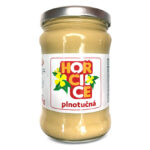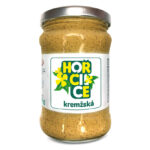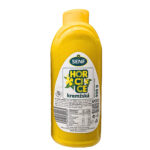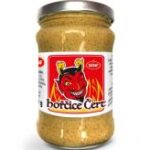
Antioxidants in Mustard Seeds. Health effects of mustard consumption
Mustard seeds contain various antioxidants that can be used to protect food from spoilage. Research has been conducted to find the most effective methods of extraction. Ultrasonic extraction reduces the required temperature and time. Additionally, the conditions for sprouting specific mustard varieties can be optimized to enhance the antioxidant properties of the seeds, potentially increasing the total antioxidant content by 49% in white mustard and 44% in black mustard. Antioxidants can also be extracted from mustard seed oil, but their quantity is 100 times lower than in the flour. Differences in antioxidant levels between the flour and the oil are influenced by plant genotype, environmental factors, and maturity. Vitamin E in mustard seeds also shows antioxidant activity, with its content varying by mustard type. The lowest amount of vitamin E is found in black mustard (453.4 mg/kg), a higher amount in brown mustard (602.1 mg/kg), and the highest in white mustard (886.95–952.2 mg/kg, depending on the variety).
Mustard seed oil oxidizes quickly after pressing. Roasting the seeds before pressing can slow this process. Roasting for 5 minutes at 165°C does not affect the fatty acid content but increases the oil’s shelf life, reducing the amount of hexanal (a marker of oil oxidation) in roasted seeds to just 13% of that in unroasted seeds. Additionally, heating white mustard seeds increases vitamin E content by 7-9% at temperatures between 120°C and 140°C. Mustard seeds also contain natural pigments. Roasting does not change the pigment quantity but slows the degradation of lutein when heating oil from roasted seeds compared to unroasted ones.
Note: Lutein is a natural pigment that improves visual acuity and protects against the blue-violet part of the visible spectrum and free radicals. It is registered as a food additive (E161b) and plays a crucial role in protecting the retina from degeneration and vision loss.
Similar findings were observed with vitamin E, which degrades more slowly in oil from roasted mustard seeds than in oil from unroasted seeds.
Mustard as a Food Additive
Due to the presence of sulfur compounds and antioxidants in mustard seeds, as well as their distinctive flavor, they can be used as a source of bioactive compounds in food products. Researchers are currently seeking nitrate substitutes for preserving meat products. Adding ground mustard can slow fat oxidation and extend shelf life. Sensory evaluations showed that products using white mustard were more favorable than those using black or brown mustard. Mustard addition effectively inhibits microorganism growth in food.
Use of Mustard Seeds to Improve Food Quality
| Study | Result | Source |
|---|---|---|
| Effect of yellow, black, and brown mustard seeds on meatball quality during storage | Ground mustard seeds positively affected color values, chemical, microbiological, and sensory properties, extending product shelf life | [59] |
| White mustard essential oil in chunky sauce | Mustard oil inhibited Salmonella growth in deliberately infected frozen chunky sauce | [60] |
| Mustard seeds in cooking broccoli | Vitamin E content significantly increased | [33] |
| Mustard seeds in organic fermented sausage without nitrates | Mustard seeds with starter cultures protected organic fermented sausage from fat oxidation without nitrates | [61–63] |
| Mustard seeds in pears in water | Mustard seed addition improved overall product perception | [64] |
| Antimicrobial film with mustard extract on Bologna sausages | Reduced undesirable microorganisms and extended shelf life | [65] |
The quality of sausage products was evaluated by adding ground mustard seeds and steaming them at elevated pressure and temperature. Mustard and starter culture addition instead of nitrates positively affected the product over 90 days of storage. During storage, the product’s pH and redox potential decreased, while antioxidant capacity increased. The level of lipid peroxidation products remained similar to samples with nitrates. Mustard seed addition reduced oxidation signs even more than nitrate samples. Additionally, steaming mustard seeds at elevated pressure and temperature produced more phenolic acids.
Note: Phenolic acids are natural antioxidants that protect products from oxidation and spoilage.
Similarly, higher phenol content, higher antioxidant capacity, and lower product pH were found in fermented pears, a traditional Greek product. Overall, mustard seed addition improved the product’s appeal. It also positively impacted lactic acid bacteria development and reduced undesirable microorganisms.
Mustard seed extract can also create an antimicrobial film on Bologna sausages. Viable bacterial levels in this product were reduced using mustard seed extract containing sulfur compounds. Food biopolymer films made from defatted mustard seed flour can be used for food coatings or standalone films. Defatted mustard seed flour, a byproduct of mustard oil production, can be used, with the best preparation method being high-pressure homogenization with 0.6% glycerin. This is a promising material for creating biopolymer films and food packaging coatings. Allyl mustard oil from oriental mustard flour can reduce toxins produced by bacteria in wheat tortillas by more than 90%. Similar results were obtained for bacteria on rye bread. The optimal temperature for mustard extract to suppress bacterial growth is 4°C to 10°C. At higher temperatures (21°C), allyl mustard oil instability does not inhibit microorganism growth. Mustard volatile essential oil, containing allyl mustard oil, is also used to create active packaging.

Erucic acid in mustard seed oil can be used to produce behenic acid, which serves as an emulsifier in food products. Mustard is one of the most allergenic foods, so it was tested to see if behenic acid derived from mustard poses a risk to allergy sufferers. However, the mustard protein content in the emulsifier is a thousand times lower than the dose causing allergies.
Proteins in mustard seeds are also valuable and can be used as food. Meat consumption continues to decline due to growing awareness of production-related issues. This trend requires replacing this popular protein source with plant-based alternatives. Mustard seeds, besides their high fat content, contain significant protein (18-24%), which can serve as a plant-based protein source. The essential amino acid content in mustard seeds is comparable to soy protein. Mustard seeds can be used to produce food components or protein concentrates. Maximum protein extraction efficiency from ground, defatted mustard seeds should be conducted at pH 12.5. Recent studies suggest high protein yields from mustard seeds can be achieved through high-pressure homogenization in piston-valve systems. This solvent-free process is based only on water and physical solutions. Additionally, mechanical cell destruction improves protein digestibility by increasing protein release from indigestible cell structures.
Mustard seed protein can be used in bread production. Mixing wheat flour with mustard flour in a 90:10 ratio during baking increases bread protein content by 5%. Bread’s acceptability (appearance, taste, smell, texture, and moisture) with this flour mix is similar to bread without mustard flour. Similar results were obtained by replacing some wheat flour with mustard flour in cookies. Replacing 20% of wheat flour with mustard seed flour in cookies increased protein content 2.5 times. The most acceptable product was achieved with a 15% mustard flour addition, but a 20% addition still had higher acceptability than cookies without mustard flour. Lower acceptability compared to 15% mustard flour addition was due to changes in physical cookie properties or the characteristic sharp taste of sulfur compounds. Bitterness can be reduced by preparing extruded mustard flour concentrates.
Health Effects of Mustard Consumption
Mustard seeds are also rich in melatonin, and mustard melatonin extract administered to rats prevented cholesterol synthesis.
Note: Health benefits of melatonin include regulating the sleep-wake cycle, antioxidant properties, maintaining a healthy immune system, cancer protection, reducing inflammation, improving mood and anxiety levels, and even slowing aging.
Mustard seeds are effective antioxidants that prevent carcinogen production. They have been noted to induce programmed cell death in colon cancer cells in studies on normal cells and human colon cancer cell lines. In mice, a mustard seed-enriched diet reduced lipid oxidation levels and increased several antioxidant enzyme activities. An interesting potential application of mustard seeds is their use as chemotherapeutic agents. Growing mustard in selenium-rich areas of India resulted in mustard seeds with high selenium content in both the meal and oil. In this case, selenium is an additional bioactive compound in mustard seeds.
Some medications, such as acetaminophen, have toxic effects on the liver, so mustard seed extract’s ability to protect the liver was investigated. Acetaminophen enhances liver enzymes by increasing reactive oxygen species levels. Mustard seed extract prevents membrane lipid degradation.
White mustard seed essential oil is a potential agent for enhancing drug penetration through the skin. Tested essential oil was found to enhance drug efficacy and was confirmed safe for skin use at concentrations below 2%.
Products derived from mustard seeds have various medical applications, including reducing liver fibrosis, stimulating wound healing, and anti-cancer properties. Soluble dietary fibers in mustard seed mucilage can reduce the risk of type 2 diabetes. Using this property to prepare puddings lowered blood glucose and insulin levels at specific post-meal times in people at high risk of type 2 diabetes.
In Nepal, mustard oil is used for newborn body massages. Comparing skin parameters after 28 days of using mustard or sunflower oil showed no significant differences, except for a faster pH decrease with sunflower oil, potentially offering better protection for infants.
Mustard can be used in analytical laboratories. Mustard seed extract gives a brown color to colonies specific to AIDS-infected fungal infections, leaving other colonies white, allowing easy differentiation.
Conclusion
Mustard is easily cultivated by farmers due to its better resistance to changing weather conditions. The high erucic acid content in mustard seed fatty acids has always been a problem, but new mustard varieties with minimal erucic acid content allow its use as a food product. The high linolenic acid levels and presence of sulfur compounds also contribute to the biological activity of mustard seed oil.
The characteristic taste of the product allows its easy use in studies, such as creating meat products using mustard as a bioactive substance. The bioactive properties of mustard are worth utilizing in other food products as well.
Looking for personalized nutritional advice? Our AI Nutritionist can tell you how mustard can be a healthy part of your diet. Get your recommendation!






